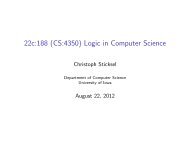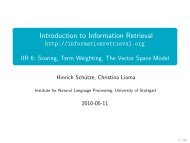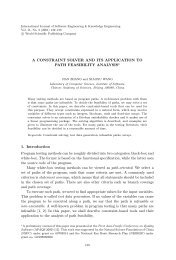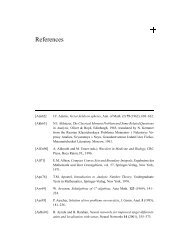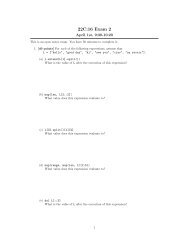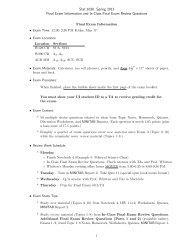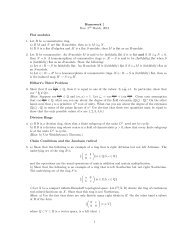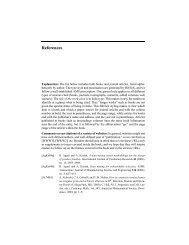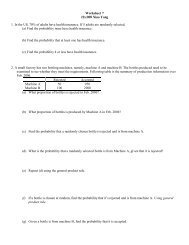Exam 2 Additional Practice Questions
Exam 2 Additional Practice Questions
Exam 2 Additional Practice Questions
You also want an ePaper? Increase the reach of your titles
YUMPU automatically turns print PDFs into web optimized ePapers that Google loves.
STAT 1030 Stats for Business Spring 2014<br />
<strong>Exam</strong> 2 <strong>Additional</strong> <strong>Practice</strong> <strong>Questions</strong><br />
DIRECTIONS:<br />
• There are 38 practice questions. Choose the single best answer. Simulate the exam experience<br />
as much as possible by answering all questions first before checking them at the back.<br />
Use incorrect answers as a guide to go back and study the associated Notebook examples,<br />
worksheet questions, quizzes, and homework.<br />
• Carry calculations to at least 4 decimal places except where directed otherwise.<br />
• Disclaimer: <strong>Practice</strong> questions provide some useful review of Topics 4–6 and show the<br />
general exam style. The types of questions on <strong>Exam</strong> 2 will differ.<br />
<strong>Questions</strong> 1–3.<br />
Classify the following variables.<br />
1. Let x = annual income earned by a restaurant manager in Iowa City, in dollars<br />
(a) discrete (b) continuous (c) binomial (d) nonrandom<br />
2. Let x = height of a randomly-selected UI student, in inches<br />
(a) discrete (b) continuous (c) binomial (d) nonrandom<br />
3. Let x = number of students traveling together in a single car on Spring Break<br />
(a) discrete (b) continuous (c) binomial (d) nonrandom<br />
<strong>Questions</strong> 4–5.<br />
The U.S. government’s Current Population Survey interviewed more than 131,000 people<br />
aged 25 or older in March 2012. The median income of the people with at least a bachelor’s<br />
degree was $44,776. The median income of people with just a high school diploma was<br />
$25,303.<br />
4. Is $44,776 a parameter or a statistic?<br />
(a) parameter<br />
(b) statistic<br />
5. Is $25,303 a parameter or a statistic?<br />
(a) parameter<br />
(b) statistic<br />
<strong>Questions</strong> 6–7.<br />
A random sample of female college students has a mean height of 65 inches, which is greater<br />
than the 64-inch mean height of all young women.<br />
6. Is the 65 inches a parameter or a statistic?<br />
(a) parameter<br />
(b) statistic<br />
7. Is the 64 inches a parameter or a statistic?<br />
(a) parameter<br />
(b) statistic<br />
1
<strong>Questions</strong> 8–11.<br />
Dell Computer, Inc. claims that 10% of computers produced during 2008 at an Austin, Texas<br />
manufacturing plant required major repair within the first five years of operation. Suppose<br />
that repair records of a random sample of 20 such computers are examined.<br />
8. What’s the probability that fewer than three computers require major repair within<br />
the first five years of operation?<br />
(a) 0.879 (b) 0.677 (c) 0.678 (d) 0.867 (e) None of the answers is correct<br />
to the third decimal place<br />
9. What’s the probability that more than seven computers require major repair within<br />
the first five years of operation?<br />
(a) 1.000 (b) 0.998 (c) 0.002 (d) 0.000 (e) None of the answers is correct<br />
to the third decimal place<br />
10. What’s the probability that between 13 and 17 computers do not require major repair<br />
within the first five years of operation?<br />
(a) 0.469 (b) 1.000 (c) 0.133 (d) 0.000 (e) None of the answers is correct<br />
to the third decimal place<br />
11. If more than seven computers in the sample require major repair within the first five<br />
years of operation, what conclusion is indicated?<br />
(a) The 10% repair rate appears to be correct.<br />
(b) It’s not possible to judge whether the 10% repair rate is correct.<br />
(c) It’s almost impossible for more than seven computers to be defective if the 10%<br />
claim is correct. The actual percentage appears to be less than 10%<br />
(d) It’s almost impossible for more than seven computers to be defective if the 10%<br />
claim is correct. The actual percentage appears to be greater than 10%<br />
(e) None of the conclusions is indicated.<br />
(more space next page)<br />
2
<strong>Questions</strong> 12–13.<br />
The polling firm Gallup, Inc. uses a random-digit dialing machine to assist in making<br />
telephone surveys. In fact, 23% of calls made by the machine reach a “live person” who<br />
answers the phone. Any given work day is considered more successful if the machine reaches<br />
more live persons on that day. Suppose that the machine makes 300 calls a day.<br />
12. What’s the minimum number of live persons reached on the 84% of all days which are<br />
most successful? (Round to the nearest person.)<br />
(a) About 62 persons (b) About 76 persons (c) About 16 persons<br />
(d) About 122 persons (e) None of the answers is correct<br />
13. What’s the maximum number of live persons reached on the 84% of all days which are<br />
least successful? (Round to the nearest person.)<br />
(a) About 62 persons (b) About 76 persons (c) About 16 persons<br />
(d) About 122 persons (e) None of the answers is correct<br />
4
<strong>Questions</strong> 14–15.<br />
On 36% of all winters, Des Moines experiences three major snowstorms. On 16% of all<br />
winters, Des Moines experiences one major snowstorm. Des Moines experiences four major<br />
snowstorms on 22% of all winters and experiences no major snowstorms on 4% of all winters.<br />
On 17% of all winters, Des Moines experiences two major snowstorms. Suppose that Des<br />
Moines never experiences more than five major snowstorms in any winter.<br />
14. Des Moines averages how many major snowstorms each winter?<br />
(a) 3 (b) 30 (c) 27.10 (d) 4.22 (e) None of the answers is correct<br />
15. Des Moines averages how many major snowstorms over a ten-year period?<br />
(a) 3 (b) 30 (c) 27.10 (d) 4.22 (e) None of the answers is correct<br />
5
<strong>Questions</strong> 16–18.<br />
The Law School Admission Test (LSAT) is a required test for applicants to many law schools.<br />
LSAT scores are given in whole numbers (0, 1, 2, . . . ) and are approximately normally<br />
distributed with a mean of 150 and standard deviation of 9.5.<br />
16. What percentage of LSAT takers score between 140 and 160 points?<br />
(a) 29.38 (b) 70.62 (c) 14.69 (d) 85.31 (e) None of the answers is correct<br />
to the second decimal place.<br />
17. What percentage of LSAT takers score more than 165 points?<br />
(a) 0.00 (b) 94.29 (c) 5.82 (d) 44.18 (e) None of the answers is correct<br />
to the second decimal place.<br />
18. A certain prestigious law school refuses to admit LSAT takers whose scores are in<br />
the lowest 80% of all LSAT scores. What is the minimum LSAT score required for<br />
admittance?<br />
(a) 136 (b) 157 (c) 142 (d) 158 (e) None of the answers is correct.<br />
(more space next page)<br />
6
<strong>Questions</strong> 19–21.<br />
Two manufacturing processes can be used to produce computer chips which regulate engine<br />
performance in new cars: Process A and Process B. The time required for Process A to<br />
produce one computer chip is uniformly distributed between 3.0 and 5.5 minutes; the time<br />
required for Process B is uniformly distributed between 2.6 and 5.3 minutes.<br />
19. What percentage of chips are produced in less than 4 minutes with Process A?<br />
(a) 50.00 (b) 49.15 (c) 60.00 (d) 51.85 (e) None of the answers is correct<br />
to the second decimal place.<br />
20. What percentage of chips are produced in less than 4 minutes with Process B?<br />
(a) 50.00 (b) 49.15 (c) 60.00 (d) 51.85 (e) None of the answers is correct<br />
to the second decimal place.<br />
21. The chip maker has two manufacturing goals: that at least 95% of chips are produced<br />
in less than 5.4 minutes, and that average time required to produce chips is no more<br />
than 4 minutes. Which processes satisfy these goals?<br />
(a) Only Process A satisfies these goals.<br />
(b) Only Process B satisfies these goals.<br />
(c) Both Process A and Process B satisfy these goals.<br />
(d) Neither Process A nor Process B satisfies these goals.<br />
(e) It is impossible to determine whether either process satisfies these goals.<br />
8
Question 22.<br />
Sam assembles dashboards at an auto plant. He assembles an average of 7.1 dashboards each<br />
day, with a standard deviation of 1.2 dashboards.<br />
22. If Sam’s production quota for the next 60 work days is to assemble at least 440 dashboards,<br />
what’s the probability that Sam will satisfy his quota?<br />
(a) 0.0000 (b) 0.0548 (c) 0.0655 (d) 0.4247 (e) 0.5753<br />
9
<strong>Questions</strong> 23–26.<br />
An auditor for the Internal Revenue Service claims that 12% of all tax returns contain at<br />
least one error. To test this claim, each return from a random sample of 250 tax returns<br />
will be carefully examined for errors. Let ̂p be the sample proportion of tax returns which<br />
contain at least one error.<br />
23. If the claim is correct, what’s the average or expected value of ̂p ?<br />
(a) 0.1200 (b) 0.5000 (c) 0.0004 (d) 0.0206 (e) None of the answers is correct<br />
to the fourth decimal place<br />
24. If the claim is correct, what’s the standard deviation of ̂p ?<br />
(a) 0.1200 (b) 0.5000 (c) 0.0004 (d) 0.3250 (e) None of the answers is correct<br />
to the fourth decimal place<br />
25. If the claim is correct, what’s the probability that 24 or fewer of the sampled returns<br />
contains at least one error?<br />
(a) 0.0600 (b) 0.8790 (c) 0.0985 (d) 0.9015 (e) None of the answers is correct<br />
to the fourth decimal place<br />
26. Suppose that you decide to doubt the auditor’s claim if the sample outcome is more<br />
rare than an event which occurs with 10% probability. Is there sufficient evidence to<br />
doubt the auditor’s claim if 24 or fewer of the sampled returns contain at least one<br />
error?<br />
(a) Yes<br />
(b) No<br />
(c) It’s not possible to determine the answer on the basis of the given information<br />
(more space next page)<br />
10
<strong>Questions</strong> 27–29.<br />
Sheila’s doctor is concerned that she may suffer from gestational diabetes (high blood glucose<br />
levels during pregnancy.) There is variation both in the actual glucose level and in the<br />
blood test that measures the level. A patient is classified as having gestational diabetes<br />
if the glucose level is above 140 milligrams per deciliter one hour after a sugary drink is<br />
consumed. Sheila’s measured glucose level one hour after consuming the sugary drink is<br />
normally distributed with µ = 125 mg/dl and σ = 10 mg/dl.<br />
27. If a single glucose measurement is made, what’s the probability that Sheila is diagnosed<br />
as having gestational diabetes?<br />
(a) 0.9332 (b) 0.0013 (c) 1.5000 (d) 3.0000 (e) None of the answers is correct<br />
to the fourth decimal place<br />
28. If measurements are instead made on four separate days and the mean result is compared<br />
with the criterion 140 mg/dl, what’s the probability that Sheila is diagnosed as<br />
having gestational diabetes?<br />
(a) 0.9332 (b) 0.0013 (c) 1.5000 (d) 3.0000 (e) None of the answers is correct<br />
to the fourth decimal place<br />
29. Suppose that Sheila’s mean glucose level µ = 125 implies that she does not suffer from<br />
diabetes. Why is it better for doctors to draw a conclusion about her case based on<br />
the sample of four measurements rather than on a single measurement?<br />
(a) Four measurements allow doctors to make three mistakes and still get a good<br />
glucose reading.<br />
(b) Four measurements reduce the probability of diabetes.<br />
(c) Four measurements might persuade Sheila to take a Statistics course.<br />
(d) Four measurements reduce the probability of misdiagnosis.<br />
(e) Four measurements constitute a random sample.<br />
(more space next page)<br />
12
<strong>Questions</strong> 30–32.<br />
30. The Z score represents<br />
(a) a probability answer between 0 and 1<br />
(b) the number of standard deviations away from the mean<br />
(c) the shaded area of the Z table<br />
(d) the standard deviation of a random variable<br />
(e) the price of beer in Mexico during Spring Break<br />
31. We study two primary types of word problems in Topic 6 (Sampling Distributions.)<br />
What are they?<br />
(a) averages and proportions<br />
(b) discrete and continuous<br />
(c) averages and standard deviations<br />
(d) random variables and nonrandom variables<br />
32. What distinguishes the variables studied in Statistics from variables studied in Algebra?<br />
(a) The variables in Statistics are nonrandom; those in Algebra are random.<br />
(b) The variables in Statistics are random; those in Algebra are nonrandom.<br />
(c) The variables in Statistics are binomial; those in Algebra are nonbinomial.<br />
(d) The variables in Statistics are continuous; those in Algebra are discrete.<br />
14
<strong>Questions</strong> 33–34.<br />
Each day, a five-person mining crew operates a digging machine in an underground copper<br />
mine in Bisbee, Arizona. The amount of raw copper ore which the crew processes each day is<br />
normally distributed and averages 12.6 tons/day, with a standard deviation of 1.7 tons/day.<br />
33. The mining company manager considers the crew’s work on any day to be acceptable<br />
if the crew processes at least 12 tons of raw ore on that day. On what percentage of<br />
days does the crew do acceptable work?<br />
(a) 36.32 (b) 77.96 (c) 63.68 (d) 80.92 (e) None of the answers is correct<br />
34. The manager recently informed the mining crew that they will all be fired if the crew’s<br />
daily work is acceptable for 22 or fewer days out of the next 30 days. What’s the<br />
probability that the crew is fired at the end of 30 days?<br />
(a) 0.1151 (b) 0.1357 (c) 0.8849 (d) 0.8643 (e) None of the answers is correct<br />
(more space next page)<br />
15
<strong>Questions</strong> 35–38.<br />
Mr. Jones is a junior high school teacher who has been given the job of supervising 2400<br />
junior high school students in the school cafeteria during lunch period. The time required for<br />
a junior high school student to finish lunch is normally distributed, and averages 63 minutes<br />
with a standard deviation of 3.46 minutes.<br />
35. Give a time range within which almost all junior high school students will finish lunch.<br />
(a) 50 to 70 minutes (b) 50 to 75 minutes (c) 55 to 70 minutes<br />
(d) 55 to 75 minutes (e) None of the time ranges is correct<br />
36. Approximately how many of the 2400 students finish lunch within one hour? (Do not<br />
round intermediate calculations. Round final answer to the nearest student.)<br />
(a) 461 (b) 1938 (c) 1939 (d) 462 (e) None of the answers is correct<br />
37. The school has given Mr. Jones the authority to end lunch period whenever he chooses.<br />
Suppose that Mr. Jones has a sadistic streak and wants to end the lunch period after<br />
only about 1800 of the 2400 students have finished lunch. How long will lunch period<br />
last?<br />
(a) 1800.00 minutes (b) 60.68 minutes (c) 65.32 minutes (d) 75.00 minutes<br />
(e) None of the answers is correct to the second decimal place<br />
38. Suppose that the cafeteria work crew can begin cleaning the cafeteria as soon as 100<br />
or fewer students are still eating lunch. How long should lunch period last in order to<br />
coincide with the beginning of cleanup?<br />
(a) 62.01 minutes (b) 64.17 minutes (c) 68.99 minutes (d) 95.83 minutes<br />
(e) None of the answers is correct to the second decimal place<br />
(more space next page)<br />
17
Solution<br />
1. a<br />
2. b<br />
3. a<br />
4. b<br />
5. b<br />
6. b<br />
7. a<br />
8. b<br />
9. d<br />
10. e P (3 < x < 7) = 0.131<br />
11. d<br />
12. a<br />
13. b<br />
14. e 2.71<br />
15. c<br />
16. b<br />
17. e 5.71%<br />
18. d 157.98, round up to 158<br />
19. e 40%<br />
20. d<br />
21. b<br />
22. c<br />
23. a<br />
24. e 0.0206<br />
25. e 0.1210<br />
26. b since 12.10% ≥ 10%<br />
27. e 0.0668<br />
28. b<br />
29. d<br />
30. b<br />
31. a<br />
19
32. b<br />
33. c<br />
34. d<br />
35. b µ ± 3σ is (52.62 to 73.38)<br />
36. a<br />
37. c<br />
38. c<br />
20



